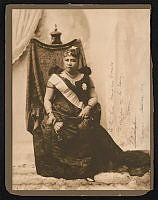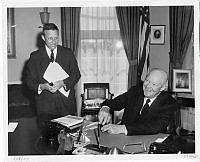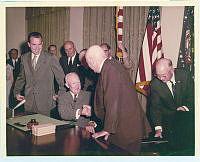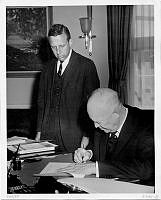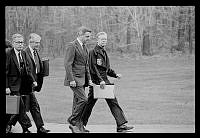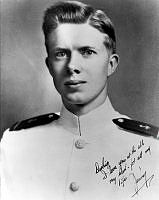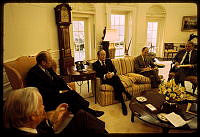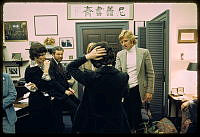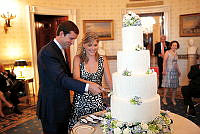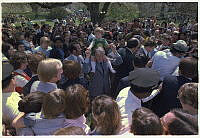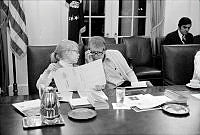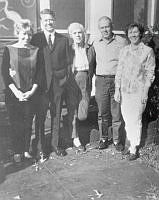Rubenstein Center Scholarship
USS Potomac: Franklin Roosevelt's Presidential Yacht
Many presidents have used ships for both relaxation and diplomacy. From fishing to meetings with foreign dignitaries, water travel provides variety and a momentary change of scenery from life and work in the White House.
From 1936 to 1945, President Franklin D. Roosevelt enjoyed travel aboard the USS Potomac. The ship, originally named the Electra, was built in 1934 as a Coast Guard Cutter and was commissioned by the U.S. Navy in 1936 after refitting and trial runs at Norfolk Navy Yard and in the Chesapeake Bay.1 Roosevelt desired a historically inspired name for the ship that would not cause confusion between ships already in service. After consulting with Captain Wilson Brown, his naval aide, the president decided on the name Potomac.
This new ship was preferred over the previous presidential yacht, the Sequoia, partly because of security concerns. While the Sequoia was made of wood, the Potomac was made of steel, which made the ship less fire-prone. The larger ship was also able to accommodate more members of the Secret Service protecting the president onboard.2
The ship was not only used for recreation but also for informal political and diplomatic meetings. To accommodate the president’s need for wheelchair accessibility, a concealed elevator was installed in what had been the rear funnel to carry the president from the main deck to the boat deck.

USS Potomac, ca. 1938
NARARoosevelt delivered one radio address from the Potomac. His remarks gave insight into his enjoyment and relaxation while aboard the ship. During a March 29, 1941 address to participants of annual Jackson Day fundraising dinners, he said, “I am sitting in the little cabin of the little ship Potomac, in the harbor of Fort Lauderdale, Florida, after a day of sunshine out in the Gulf Stream . . . I try to get away a couple of times a year on these short trips on salt water. . . Even when I go to Hyde Park or to Warm Springs, the White House office, the callers, and the telephones all follow me. But at sea the radio messages and the occasional pouch of mail reduce official work to not more than two or three hours a day.”3
During the 1936 presidential campaign, Roosevelt once told his opponent, Kansas Governor Alfred “Alf” Landon, “If you are elected President, I can give you one good piece of advice. Get yourself a boat to go down the Potomac.”4
While relaxing on board, the president fished, read detective stories, and worked on his stamp collection. On Sundays, a sea plane would often land alongside the ship to deliver newspapers, mail and anything requiring the president's signature.5 Newspapers occasionally reported on the fishing prowess of the president, with one paper commenting on a 1936 fishing trip that, “when the yacht reached Caicos Island in the Bahamas . . . the Roosevelt luck returned. . . the catch including large kingfish, mackerel, groupers and barracuda.”6
One of the most well-known prewar uses of the boat occurred during the June 1939 visit of King George VI and Queen Elizabeth of Great Britain. The ship carried the royal couple and President and Mrs. Roosevelt down the Potomac River from Washington, D.C. to nearby Mount Vernon, the former home of George Washington. Newspapers described the ship with the royal standard of the King of England on the foremast and the U.S. presidential flag on the main mast.7 A 21-gun salute greeted the royal couple as they entered the Navy Yard prior to boarding. Soon after arriving at the first president’s estate, the Potomac was moored to dock where one news reporter noted, “the stifling, windless day had left the river flat and seemingly motionless as the vessel was tied against the wharf.” After a tour of Mount Vernon and a visit to Washington’s tomb, the royal and presidential entourage returned to Washington, D.C. via automobile.8

The USS Potomac with President Franklin Roosevelt and the King and Queen of Great Britain onboard as the ship travels from Washington to Mount Vernon and back on June 9, 1939.
Franklin D. Roosevelt Presidential Library and Museum/NARAThe ship was also used in August 1941 as part of a stealth operation while President Roosevelt secretly met with British Prime Minister Winston Churchill to draft the Atlantic Charter.9 Afterwards, President Roosevelt hosted a press conference onboard the Potomac in which he explained the secrecy of the meeting, given the potential threat of a German submarine attack: “Things of that kind cause trouble, if you make known the exact location on the high seas of the President and the Prime Minister.”10
After the death of President Roosevelt, the Potomac was decommissioned. Under President Harry S. Truman, the Williamsburg, a former World War II gunboat, became the new presidential yacht.11 Before the Williamsburg became the official presidential yacht in September 1945, Truman and his family enjoyed the Potomac briefly, including one early May 1945 Potomac River excursion.12
For several decades, the Potomac served a variety of roles for a number of owners. Briefly returned to the Coast Guard, the Potomac resided in Maryland for about a decade. The ship then served as a ferry between Puerto Rico and the Virgin Islands. The ship was then taken to California with the intention of serving as an attraction at the 1962 Seattle World Fair. This plan failed and it seemed as if the historic ship was destined for the scrap heap.
Music legend Elvis Presley intervened and bought the ship in 1964 with the desire that it be given to the March of Dimes Foundation and preserved as a “national shrine.” Elvis’s manager, Colonel Tom Parker said of Presley’s intentions that “Elvis feels the yacht could be a strong source for donations in memory of the late Presidents Roosevelt and John F. Kennedy.”13 The foundation, concerned over maintenance cost and the overall mission of their organization declined the offer with regret.

President Franklin Roosevelt enjoys time aboard the Potomac while on the Hudson River in 1937.
Franklin D. Roosevelt Presidential Library and Museum/NARAAfter several more owners, the ship sank after being towed to Treasure Island in San Francisco Bay when several pilings pierced her hull. Raised two weeks later, the ship was sold by U.S. Customs to the Port of Oakland. Spearheaded by the Port, the Potomac was preserved and restored during a 14 year collaborate effort by President Roosevelt's son, James, multiple organizations, and many dedicated volunteers.
The Potomac, now a National Historic Landmark, is maintained by the Association for the Preservation of the Presidential Yacht Potomac. It resides today in Oakland, California and has been open to the public since 1995.14

President Franklin Roosevelt and First Lady Eleanor Roosevelt with the King and Queen of Great Britain aboard the Potomac in 1939.
Library of Congress












